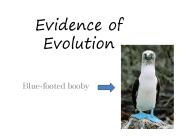Microevolution PowerPoint PPT Presentations
All Time
Recommended
Microevolution Microevolution considers mechanisms that cause generation-to-generation changes in allele frequency within populations. Changes in allele frequency ...
| PowerPoint PPT presentation | free to download
Toothpaste sorbitol Salad Dressing high fructose corn syrup Gum HFCS, sorbitol, or maltitol Make Up starch (filler) Milk ...
| PowerPoint PPT presentation | free to view
Selective breeding practices yield evidence that heritable changes ... English bulldog. Short snout and compressed face. Extreme traits lead to health problems ...
| PowerPoint PPT presentation | free to download
Change in the gene pool of a population. Change in the relative ... Population group of organisms that interbreed. Tree of Life. Insects. Beetles. Species ...
| PowerPoint PPT presentation | free to view
Microevolution- changes in the frequencies of alleles of ... Cockroach traps baited with glucose; cockroaches with aversion to glucose becoming more common ...
| PowerPoint PPT presentation | free to view
Phenotypic Variation in a population of butterflies. The Case of the Peppered Moths ... 490 AA butterflies. The next generation: 420 Aa butterflies. 90 aa butterflies ...
| PowerPoint PPT presentation | free to view
Phenotypic variation may be environmental and/or genetic in origin ... Example: Bill Size in African Finches. 10. 20. 30. 40. 50. 60. Number of individuals. 10. 1.12 ...
| PowerPoint PPT presentation | free to view
'In nature, all things are alike in this, in that they can be traced to preceding ... These ideas led to his theory catastrophism. ...
| PowerPoint PPT presentation | free to view
Microevolution (Ch 23) and Macroevolution (Ch 24)
| PowerPoint PPT presentation | free to view
Persistence of multiple traits can be qualitative or quantitative. Population ... Heterosis. Heterozygote is favored. Gene flow. Flow of alleles between populations ...
| PowerPoint PPT presentation | free to view
The Process of Microevolution Selection: Directional, Stabilizing, and Disruptive Selection Microevolution vs. Macroevolution Microevolution: change in allele frequency
| PowerPoint PPT presentation | free to download
Title: Microevolution: How Does a Population Evolve? Author: mgilmore Last modified by: mgilmore Created Date: 11/3/2004 7:15:30 PM Document presentation format
| PowerPoint PPT presentation | free to download
isolation, migration, natural selection and mutation. ... Meadowlarks. Eastern Western. Islands. Island Canyon. Orchids. Mutations ...
| PowerPoint PPT presentation | free to view
... there are only three genotypes A1A1, A1A2, and A2A2, ... we can classify selection on such ... Draw a fitness landscape and a population on each such that ...
| PowerPoint PPT presentation | free to download
Title: Natural Selection Author: PhillipJ.Jenkins Last modified by: Carver, Brandy Created Date: 9/8/2006 1:34:06 AM Document presentation format
| PowerPoint PPT presentation | free to view
The South Atlantic island of Tristan da Cunha was colonized by 15 Britons in ... If these trends were to continue with no cultural changes in the town for the ...
| PowerPoint PPT presentation | free to view
Process by which a population's genetic structure changes = microevolution ... Ex: Fruit flies with more bristles prefer other bristly flies and vice-versa ...
| PowerPoint PPT presentation | free to view
Evolution & Microevolution Tutorial Introduction Microevolution Hardy Weinberg Equilibrium Practice! * * * Practice with Hardy Weinberg Now we know how many of our ...
| PowerPoint PPT presentation | free to download
Mechanisms of Microevolution There are 5 mechanisms that affect real populations resulting in microevolution or changes to allele frequencies within a population.
| PowerPoint PPT presentation | free to view
Microevolution in Modern Human Populations Human ... Human Biocultural Evolution Polymorphisms ABO Blood Group system Rh system MN blood group Human Biocultural ...
| PowerPoint PPT presentation | free to download
there are several mechanisms for evolution. new phenotypes do occur ... antelope. male. female. www.cathouse-fcc.org. Elephant. seal. female. male. www.indie.ca ...
| PowerPoint PPT presentation | free to view
... unless outside forces change those frequencies. ... of A from male & a from female, or a from male & A from female: (pm x qf ) (pf x qm ) = 2pq ...
| PowerPoint PPT presentation | free to view
Microevolution in the MAP Kinase Cascade. Angela M. Berg and H. Frederik Nijhout. Results and Conclusions ...
| PowerPoint PPT presentation | free to view
... of Darwin's two main contributions in the Origin is the idea of 'Descent with ... Main Ideas in the Origin. descent with modification (phylogenetic trees, ...
| PowerPoint PPT presentation | free to view
Evolution occurs at the population level as allele frequencies ... Albinism among Arizona's Hopi Indians. 2. Migration. Individuals migrate between populations. ...
| PowerPoint PPT presentation | free to view
Evolution on two scales Microevolution- Changes in gene frequencies in a population brought about by mutation, gene flow or natural selection. ...
| PowerPoint PPT presentation | free to download
Natural selection results in development of features which increase an ... are the chances an organism has of inheriting a gene if there are only two ...
| PowerPoint PPT presentation | free to view
In this case, it was predicted that the wild-type flies would flourish in both ... 28, 2006, from http://biology.arizona.edu/sciconn/lessons2/Geiger/ intro2.htm ...
| PowerPoint PPT presentation | free to view
Microevolution Evolution that occurs within a population is called microevolution. Causes of Microevolution 1. Mutations Mutations are permanent genetic changes ...
| PowerPoint PPT presentation | free to download
Ecology = the study of interactions ... Microevolution Macroevolution small changes large changes. Microevolution = adaptation. Macroevolution = speciation ...
| PowerPoint PPT presentation | free to view
Evidence of Evolution Blue-footed booby * * Evidence of evolution Fossil Record Anatomy Embryology Biochemistry Evidence in microevolution Mold ...
| PowerPoint PPT presentation | free to download
Microevolution Macroevolution Usually a population gets separated Different populations encounter different environments and accumulate different traits When they are ...
| PowerPoint PPT presentation | free to view
EVOLUTION AND NATURAL SELECTION Miss Napolitano & Mrs. Haas CP Biology Patterns of Microevolution Directional selection: selects for one extreme trait Where malaria ...
| PowerPoint PPT presentation | free to view
Title: Concept 14.4: Microevolution is a change in a population s gene pool. Author: Employee Last modified by: Employee Created Date: 4/5/2005 12:38:12 PM
| PowerPoint PPT presentation | free to view
... (Lamarkism) There is no difference between macroevolution and microevolution. Macroevolution is merely a collection of microevolution events.
| PowerPoint PPT presentation | free to view
... Evolution Evolution is the process by which modern organisms have descended from ancient ones Microevolution Microevolution is evolution within a single ...
| PowerPoint PPT presentation | free to download
Forces that drive evolution Inheritance Random Genetic Change Natural Selection Genetic drift Migration Etc. Punctuated Equilibrium Adaptive Radiation Microevolution ...
| PowerPoint PPT presentation | free to view
... Lobe finned fishes Amphibian-like fishes Fish-like amphibians Amphibians Reptile-like amphibians Amphibian-like reptiles Reptiles Etc. Microevolution vs ...
| PowerPoint PPT presentation | free to view
Microevolution = a change in the genetic makeup of a population from one generation to the next ... Inbreeding and assortive mating cause. an increase in homozygotes. ...
| PowerPoint PPT presentation | free to view
Microevolution: The change in the frequency of alleles in a population s gene pool. Macroevolution: That change of one species into another.
| PowerPoint PPT presentation | free to view
Population genetics Study of evolution from a genetic point of view. Microevolution Change in the collective genetic material of a population Population A group of ...
| PowerPoint PPT presentation | free to view
What are the major differences between microevolution and macroevolution? 3. What are the four main factors that can alter genetic diversity? 4.
| PowerPoint PPT presentation | free to download
Chapter 25: Phylogeny and Systematics Macroevolutionary Relatedness Microevolution is Macroevolution is Connections... Fossils Classifying Organisms Taxonomic ...
| PowerPoint PPT presentation | free to view
Darwin Club. Lecture 13: Microevolution ... Fitness is the contribution that the allele makes towards the individual's ... The fitness values of the three ...
| PowerPoint PPT presentation | free to view
Growth within species; species created; microevolution ... Bacterial Flagellum. Chromosome. DNA. Galaxies and Nebulae. Big Bang Simulation. Evolution = Freedom ...
| PowerPoint PPT presentation | free to view
Patterns produced by microevolution that are visible at a larger scale ... Santa Cruz Island Jay. Catalina Ironwood. Hawaiian I'iwi. Relict distribution ...
| PowerPoint PPT presentation | free to view
Microevolution refers to change in the allele frequencies within a ... Geologic processes constantly change and ... A Bullfrog is also known ...
| PowerPoint PPT presentation | free to view
Evolutionary Concepts: Variation and Mutation 6 February 2003 Definitions and Terminology Microevolution Changes within populations or species in gene frequencies and ...
| PowerPoint PPT presentation | free to download
Microevolution Macroevolution Introduction The concept of evolution, that organisms may change over time, was not new in Darwin s time.
| PowerPoint PPT presentation | free to download
Natural selection acts on distributions of traits. ... Microevolution is evolution within a population. observable change in the allele frequencies ...
| PowerPoint PPT presentation | free to view
... Natural selection As a result, the gene pool in the next generation differs from that of the previous generation - microevolution. Natural Selection ...
| PowerPoint PPT presentation | free to view
What is Population Genetics? About microevolution (evolution within species) The study of the change of allele frequencies, genotype frequencies, and phenotype ...
| PowerPoint PPT presentation | free to download
Microevolution = decide whether the blue people of Appalachia are evolving ? Martin Fugate s Family (redheaded bride) Meet the Fugates ...
| PowerPoint PPT presentation | free to view
When gene pool frequencies change, microevolution has occurred ... (2) Sympatric Speciation. One population develops into two or more reproductively isolated groups ...
| PowerPoint PPT presentation | free to view
... Big Concepts Heritability of Traits DiHybrid Cross Fig. 5.2a Fig. 5.2b Translation Animal of the Day Natural Selection Microevolution Macroevolution ...
| PowerPoint PPT presentation | free to view
1. Genetic Variability may come from mutations and immigration. ... Cheetahs. Pure bred dogs. Microevolution. Macroevolution. Speciation. Biological Species Concept ...
| PowerPoint PPT presentation | free to view
























































